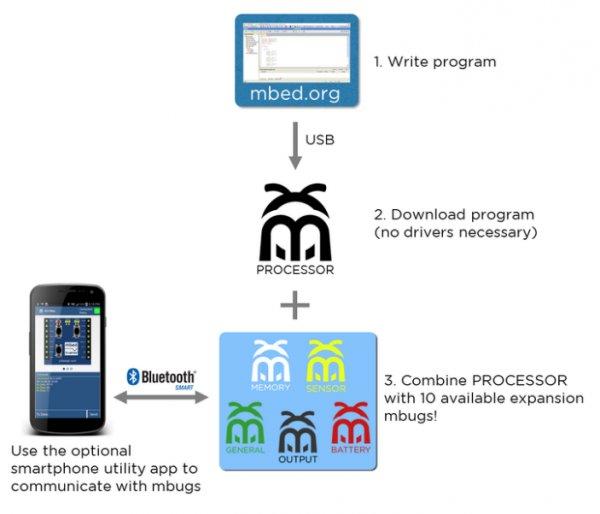mbugs™
The mbug™ ecosystem is the integration of miniaturized electronics based around the ARM Cortex-M microcontroller, the free ARM mbed online compiler, and an intuitive smartphone utility app!
Whether you are a student, hobbyist, or engineer, the mbug ecosystem enables you to quickly implement your electronics projects.
mbugs are simple enough that you don’t need to be an expert to turn your idea into a working creation, yet powerful enough to meet the needs of the advanced user.
With mbugs, what will you create?
The mbug ecosystem uses the mbed online compiler and SDK where you can quickly create embedded applications that are easily downloaded onto the mbug processor through a standard USB interface, just like adding a file to a USB flash drive.
In addition to the processor mbugs which run the applications, we’re offering a number of expansion mbugs that can be stacked onto the processor to create multifunctional systems. Together, you can use mbugs to build projects containing sensors, displays, relays, and servo motors.

Finally, we’re providing a free Android app which makes it easy to send and receive data from your smartphone to your mbug projects.
System Overview
The graphic below shows how the system works. Programs are written, compiled, and downloaded using the online compiler on mbed.org.
The compiled program is transferred over a USB cable onto one of two processor mbugs, depending on which you choose for your project.
The processor mbugs can be stacked onto one or more expansion mbugs depending on the functions your project requires.
With the free open source Android utility app, you can send and receive custom data and events, and graph real-time sensor data – all over a Bluetooth Low Energy link.
Processor mbugs
Select from either the wired or wireless PROCESSOR mbugs:
1. PROCESSOR mbug (white) – use for projects that don’t require wireless. Download applications directly using USB. Click here for our PROCESSOR platform page on mbed.org.
2. BLE PROCESSOR mbug (blue) – provides wireless capability, and uses the PROCESSOR mbug (#1 above) as the USB programming interface. Click here for our BLE PROCESSOR platform page on mbed.org.
Expansion mbugs
While the programs reside on the processor mbugs, the expansion mbugs provide the extra functionality, allowing you to build really cool projects. We are initially offering 10 expansion mbugs, from sensors and memory, to a battery and a relay – and more! We tried to start with the functions that most of you will want, but with your support – this is only the start!
Software IDE
We believe mbed is great. The beauty of it is in the hardware abstraction which allows you to focus on the smarts of your project rather than on the details of the underlying hardware.
ARM’s mbed is completely open-source and has an online developer community of over 100,000 members who have already contributed to huge numbers of example libraries and programs, so you will be able to get your project up and running quickly. Plus, by the time mbugs ship, we are committed to providing our own example libraries for our expansion mbugs to doubly ensure your time can be spent on your project, not wasted on unnecessary deep dives into spec sheets and application notes (we’ve already done this, so why should you have to?).
are mbugs also for beginners?
We believe both the mbug platform and mbed, are perfect for beginners who want to learn how to program. Our vision is for our product to be used by beginners, kids, and students because on mbed, writing programs can hardly be any easier.
Here’s why. To make your programs do anything interesting, often there is a lot of setup and complicated steps to do the most basic of operations. That’s why mbed is unique and great – it makes controlling LEDs, buttons, sensors and other functions as easy as can be. No drivers or software installation required, no wires, no complex setup, and no mapping of pins to LEDs, buttons, etc.
Here’s an example program. When you start with your first new program on mbed, you can easily import an already completed example as a starting point called “blinky”, shown in the image below.
We’ve included the green comments to show you exactly what is happening. The example blinky program blinks the first led on the mbug by turning it on and off every 0.2 seconds. This actually isn’t unique to our product, but will run on any of the platforms available on mbed.org. However, we feel our product is a good starter kit because you can begin by writing simple programs on a processor mbug, and as you become more comfortable, you can start incorporating programming with the expansion mbugs.
Of course, there are example programs like the one above to get you started.
key features:
- smaller than a quarter, at approximately 0.9″ x 0.9″
- 12 different mbugs (2 processors, 9 expansion, 1 prototype)
- Lithium polymer battery mbug for completely standalone projects
- separate-able programming hardware for BLE mbug
- stackable 100-mil pitch dual 8-pin connector
- standardized pinout strategy to ensure interoperability
- provides standard interfaces (USB, UART, SPI, I2C)
- mbed online compiler, with example code
- free Android smartphone utility app
For more detail: mbugs – rapid-prototyping electronics for hobbyists and pros
